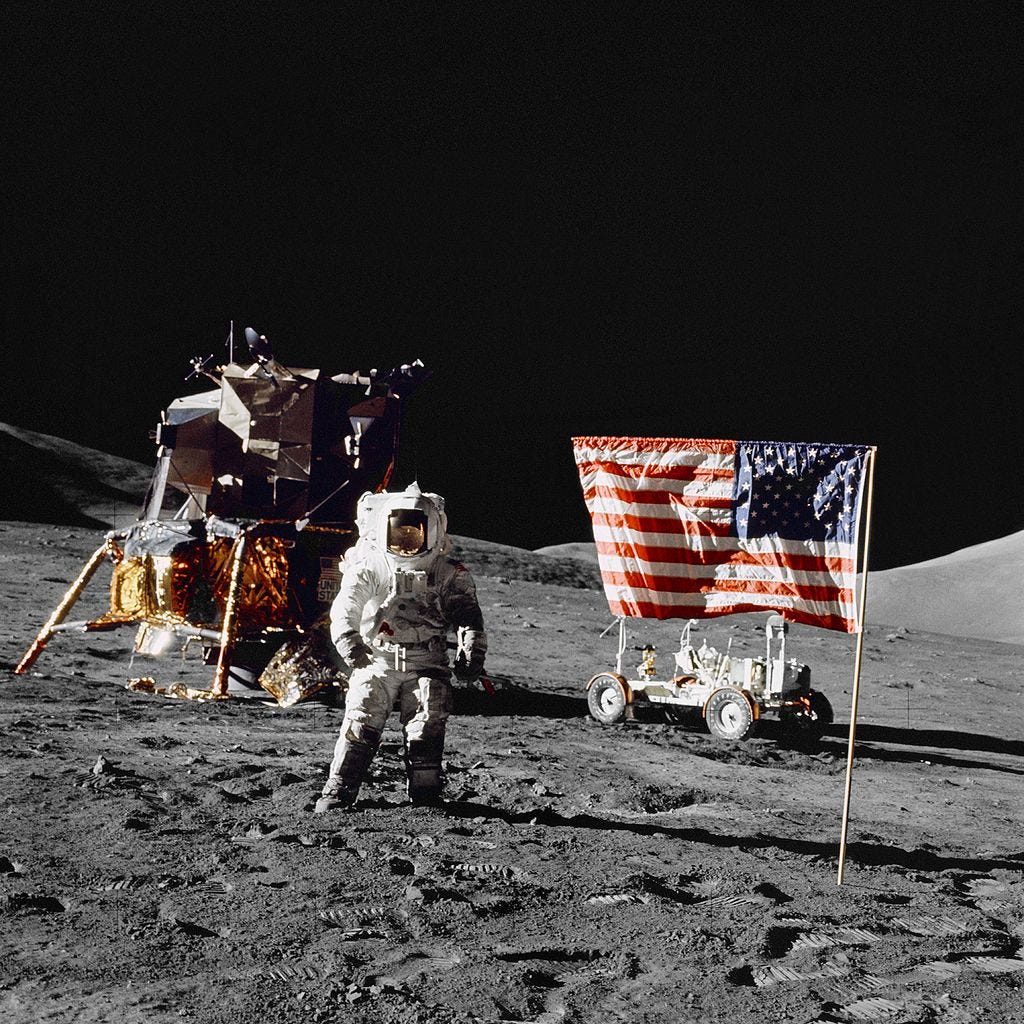Marine Lightnings fly with drones and the looking back on the end of a lunar era
Marine Lightnings team up with Valkyrie drones and remembering the last Apollo mission.
"The engine is the heart of an airplane, but the pilot is its soul."
– Walter Raleigh
Mission Briefing:
In a significant advancement for military aviation, the U.S. Marine Corps has successfully integrated the XQ-58A Valkyrie unmanned aircraft with F-35 Lightning II stealth fighters during the recent Emerald Flag 2024 exercises at Eglin Air Force Base, Florida. This collaboration marks a pivotal step in the Marine Corps' exploration of manned-unmanned teaming concepts.
The XQ-58A Valkyrie, developed by Kratos Defense & Security Solutions, functioned as a forward-deployed sensor platform, effectively transmitting critical threat targeting data to the F-35s. This capability enhances situational awareness and combat effectiveness, allowing manned aircraft to engage targets identified by their unmanned counterparts.
This exercise represents the fourth test flight of the Valkyrie, underscoring its potential to operate autonomously or in conjunction with manned aircraft. The successful integration during Emerald Flag 2024 highlights the Marine Corps' commitment to leveraging emerging technologies to maintain a strategic edge.
The XQ-58A Valkyrie is part of the U.S. Air Force's Low Cost Attritable Strike Demonstrator program, aiming to develop cost-effective unmanned systems capable of performing alongside traditional fighter jets. Its ability to operate using AI-driven autonomy positions it as a versatile asset in modern combat scenarios.
The Marine Corps' experimentation with the Valkyrie reflects a broader trend in military aviation toward integrating unmanned systems to enhance operational capabilities. As these technologies mature, they are expected to play an increasingly prominent role in future military operations.
This week in aviation history
This Week in Aviation and Space History: Apollo 17's Legacy
On December 11, 1972, the crew of Apollo 17—the final mission of NASA's Apollo program—touched down on the Moon's surface. This mission marked the end of humanity's first great era of lunar exploration. Commander Eugene Cernan, Lunar Module Pilot Harrison "Jack" Schmitt, and Command Module Pilot Ronald Evans carried the dreams and aspirations of an entire planet as they embarked on a journey that would cement Apollo 17 as one of the most scientifically valuable lunar missions in history.
Mission Briefing
This Week in Aviation History
11 December 1972: Apollo 17 was a mission of firsts and lasts. It was the last crewed lunar mission, the first night launch of the Saturn V rocket, and the only mission to include a trained geologist, Jack Schmitt, as part of the crew. The addition of Schmitt emphasized NASA's shift toward maximizing the scientific returns of lunar exploration.
The mission's primary goals included:
Exploring the Taurus-Littrow Valley, a region selected for its geologically diverse terrain.
Collecting lunar samples that could shed light on the Moon's volcanic and tectonic history.
Deploying scientific instruments, including the ALSEP (Apollo Lunar Surface Experiments Package), to study the Moon's environment.
The Final Footprints
Cernan and Schmitt spent a record-breaking 22 hours on the lunar surface during three moonwalks, traversing more than 22 miles with the aid of the Lunar Roving Vehicle (LRV). Among their notable achievements:
Collecting 741 rock and soil samples, including the famous "orange soil", which was later found to be volcanic glass formed over 3 billion years ago.
Capturing breathtaking images of the lunar landscape, including "The Blue Marble", a photograph of Earth taken by the crew en route to the Moon that became one of the most iconic images in human history.
Leaving behind a plaque inscribed with the words:
"Here man completed his first explorations of the Moon, December 1972 A.D. May the spirit of peace in which we came be reflected in the lives of all mankind."
Cernan, the last human to leave the lunar surface, remarked poignantly:
"We leave as we came, and, God willing, as we shall return—with peace and hope for all mankind."
Scientific Triumphs
Apollo 17 significantly advanced our understanding of the Moon and its history. The samples returned provided evidence of ancient volcanic activity and confirmed that the Moon once had a magnetic field. Data collected from the mission's instruments also contributed to understanding lunar seismic activity and the Moon's tenuous atmosphere.
Why It Matters Today
Apollo 17 wasn't just a conclusion; it was a beginning. The scientific data, engineering lessons, and inspiration it provided have shaped the foundation for modern lunar exploration. Missions like Artemis, which aim to return humans to the Moon in the coming decade, are direct descendants of Apollo's legacy.
Cernan's closing words resonate deeply as humanity prepares for the next chapter of lunar exploration:
"America's challenge of today has forged man's destiny of tomorrow."
Looking Ahead
As we reflect on Apollo 17, we celebrate the courage and ingenuity that defined the Apollo program. The mission’s legacy reminds us of what humanity can achieve when we dare to explore the unknown. Today, as new spacecraft and bold ambitions reignite our lunar dreams, the footprints of Apollo 17 on the Moon's surface remain a testament to our collective aspiration to reach beyond. It has been too long - and we need to go back.
In Case You Missed It
The latest on the B-21 Raider:
Photo Outlet
Over the next year I will be releasing some of the best photos I took at the airshow, here is the next series:
Feel free to use these photos however you like, if you choose to tag me, I am @pilotphotog on all social platforms. Thanks!
Post Flight Debrief
Thanks for reading! Want to keep getting this newsletter straight to your inbox? Just sign up using the form below—it's that easy! This newsletter will always be free for everyone, but if you’d like to support the mission and unlock even more, consider becoming a paid subscriber. Either way, I’m grateful for your support. Sign up now and stay in the loop!
-Tog






